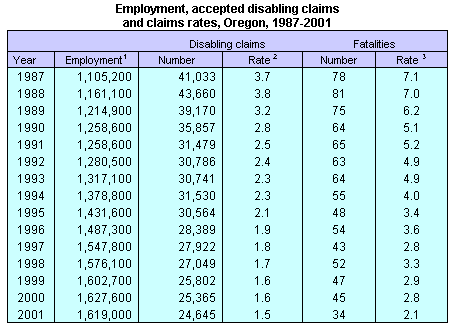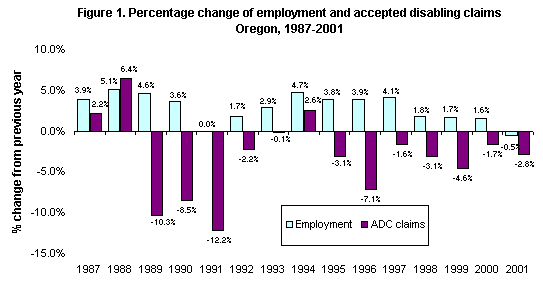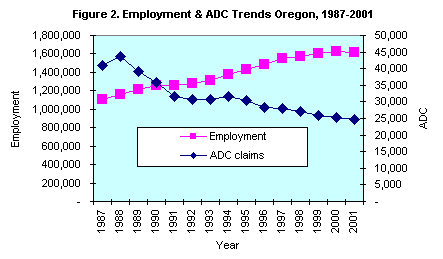
First Glance at
Accepted Disabling Claims, 2001
by Juli Ross-Mota
The Oregon Workers' Compensation Division (WCD) received 24,645 accepted
disabling workers' compensation claims during calendar year 2001. Of these
claims, 34 were fatalities. Accepted disabling claims are claims that
are accepted by insurers and received by WCD for disabling occupational
injuries or diseases. This is the lowest number of accepted disabling
claims received since legislative reforms made workers' compensation insurance
mandatory for most employers in 1966 and standardized data collection
began.

|
Notes: 4. Link to major industry division rates. |
The statewide claims rate declined to 1.5 claims per 100 workers, the lowest claims rate ever recorded in Oregon (see table above). The fatalities rate declined to 2.1 claims per 100,000 workers, and is also the lowest rate on record.

The number of accepted disabling claims dropped 2.8 percent from the 2000 figure; at the same time, the number of workers covered by workers' compensation declined by 0.5 percent (see Figure 1). The pattern of recent years had been characterized by declining numbers of accepted disabling claims from an expanding pool of workers. The year 2001 represents the first downturn in covered employment since 1982. Between 1997 and 2001, the number of workers covered by Oregon's workers' compensation law increased 4.6 percent, while the number of accepted disabling claims declined 11.7 percent.

The trend of steadily declining numbers of claims and claims rates began in the late eighties (see Figure 2), following record high premium rates, claims costs, and numbers of claims. In 1986, Oregon employers paid the sixth highest average workers' compensation premium rates in the country. At the same time, medical and permanent disability costs for injured Oregonians were among the highest in the nation, while benefits were considered among the lowest. These factors led to many reforms to Oregon's workers' compensation system.
The 1987 legislature took the first major step by enacting HB 2900. This bill expanded OR-OSHA's consultative program, requiring insurers and self-insured employers to provide safety and health loss prevention programs, and increasing penalties against employers who violate the Oregon Safe Employment Act. Three years later, SB 1197 and SB1198 were passed. SB1197 extended HB 2900 by requiring many employers to establish safety and health committees.
With SB 1197, the legislature also changed the definitions of compensability
for both injuries and diseases. Reforms required that a compensable injury
or disease be established by medical evidence and supported by objective
findings. In addition, the compensable injury must be the major contributing
cause for the worker's condition. For an occupational disease claim to
be compensable, the condition must be caused by substances or activities
to which an employee is not ordinarily subjected. Injuries from recreational
and social activities are excluded. Injuries arising from the use of alcohol
or drugs are excluded when proven by clear and convincing evidence that
the alcohol or drug is the major contributing cause of the injury. (In
1995, the legislature reduced the standard of proof to the "preponderance
of evidence.") More refinements to the reforms were enacted during
subsequent legislative sessions.
In addition to the effects of workers' compensation reforms, changes in claims handling procedures and claims management by insurers and employers have been reported as contributing to the decline in accepted disabling claims. Another influence may be a shift in Oregon's economy over the past 15 years, with fewer workers in the hazardous wood products industry, and more workers in comparatively safer high-tech and service industries.
Finally, the increased emphasis on safety and health has played a vital role in the reduction of both the numbers and frequencies of work-related claims in Oregon. With employers, workers, and government working together, Oregon's work sites have become safer.
DCBS Public Home Page | DCBS
Site Search | IMD
Search |IMD Home
Page|
If you have questions about the information contained in this document, please contact by e-mail or phone: Juli Ross-Mota , Research Analyst, Research & Analysis Section, Information Management Division (503) 947-7359.
This web page was last revised: 09/13/02